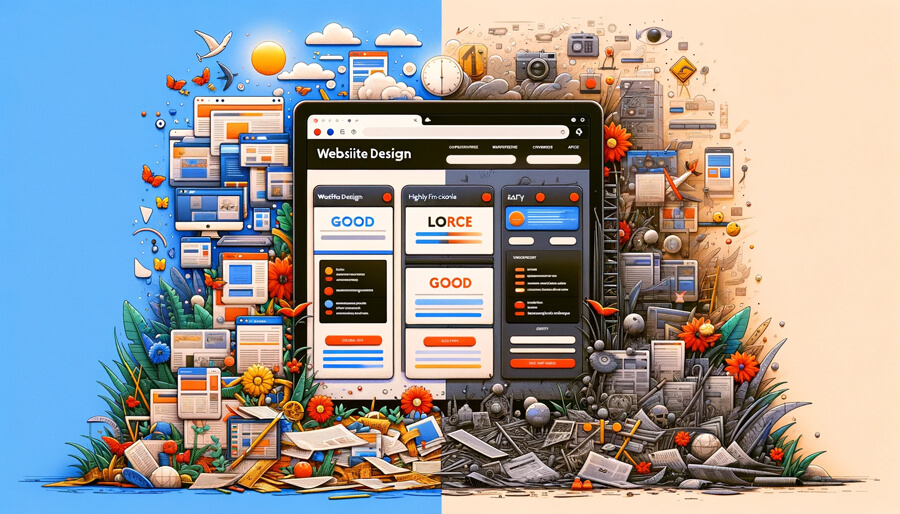Designing an Impactful Website: Significance and Expert Tips
In today's digital era, your website serves as the virtual face of your business or personal brand. It acts as the primary point of contact for potential customers or visitors, underscoring the pivotal role that its design plays in shaping a lasting impression. Whether you're embarking on the creation of a brand-new website or contemplating a redesign, the choice of design is of paramount importance. In this comprehensive guide, we'll delve into the profound importance of website design and furnish you with invaluable tips for crafting or selecting the ideal design for your online presence.

Why Website Design Matters
1. Crafting a Memorable First Impression
Your website often serves as the initial point of contact between users and your brand or content. A thoughtfully crafted design possesses the unique ability to captivate visitors, etching a positive and unforgettable first impression. Conversely, a poorly designed website can deter users from exploring further.
2. Elevating User Experience
The design directly shapes how users navigate and engage with your website. An intuitive and user-friendly design facilitates seamless navigation, encouraging users to delve deeper into your content and prolong their stay.
3. Fostering Credibility and Trust
A professional and refined design nurtures trust within your audience. People are inherently more inclined to engage with a website that exudes credibility and reliability, setting the stage for meaningful interactions.
4. Reflecting Brand Identity
Your website's design should serve as a visual representation of your brand's identity. Maintaining consistency in design elements such as colors, fonts, logos, and navigation menus bolsters your brand's visual recognition and reinforces its identity.
5. Driving Conversion Rates
Effective design isn't solely about aesthetics; it can significantly boost conversion rates. Whether your objective is to drive sales, garner sign-ups, or encourage content consumption, a well-structured website design has the potential to sway user behavior in a positive direction.
6. Embracing Mobile Responsiveness
In an era marked by the ubiquity of mobile devices, responsive design is no longer an option; it's a necessity. A mobile-friendly website ensures that users accessing your site via smartphones and tablets encounter a frictionless and gratifying experience.
Choosing the Right Website Design

Website design is very important for the promotion and development of your business. Now we are all used to having everything available to us on the Internet. So your site should be convenient and useful for your client, as well as pleasant to the eye and stand out from others. For example, the Hell Spin website is a great example of how a website should look and work. Be sure to check out this site to bring fun to your life and make your site better. Well when it comes to selecting or creating the right website design, here are some essential tips to consider:
Understand Your Audience
Before diving into design, understand your target audience's preferences, needs, and behavior. Research your audience's demographics and tailor your design to cater to their expectations.
Simplicity is Key
Keep your design clean and uncluttered. Avoid overwhelming users with too much information or complicated layouts. Simplicity enhances user experience and readability.
Visual Hierarchy
Use design elements like contrasting colors, typography, and spacing to create a visual hierarchy. Guide users' attention to important content and calls to action.
Consistency
Maintain consistency in design elements across your website. This includes fonts, colors, logos, and navigation menus. A consistent design enhances brand recognition.
Mobile-Friendly
Ensure your design is responsive, adapting seamlessly to different screen sizes. Test your website on various devices to guarantee a smooth user experience.
Page Loading Speed
Optimize images and use clean, efficient coding to ensure fast page loading times. Slow-loading pages can deter users.
Navigation
Create an intuitive navigation structure. Users should easily find the information they're looking for. A well-organized menu and clear labels are essential.
Content Layout
Pay attention to how content is presented. Use headings, subheadings, and bullet points to break up text. Make use of whitespace to improve readability.
Color Psychology
Colors evoke emotions and convey messages. Choose a color scheme that aligns with your brand and resonates with your audience. Consider the psychological impact of different colors.
User Testing
Before finalizing your design, conduct user testing. Gather feedback from potential users to identify any usability issues or areas for improvement.
Designing for Different Types of Websites
The ideal design can vary depending on the type of website you're creating. Here are some design considerations for various website categories:
E-commerce
Focus on product presentation, user-friendly navigation, and a streamlined checkout process. High-quality images and clear product descriptions are essential.
Portfolio or Creative
Showcase your work or creative projects effectively. Use visually appealing galleries and provide context for each piece.
Blog or Content-Based
Prioritize readability and easy content consumption. Implement a clean and organized layout with an accessible archive of articles.
Corporate or Business
Emphasize professionalism and trustworthiness.
Nonprofit or Cause
Convey the mission and impact of your organization. Use visuals and stories to engage visitors emotionally.
The Importance of Keeping Your Website Design Updated
Once you've chosen or crafted the right design, remember that website design is not static. It should evolve to meet changing trends and user expectations. Here's why keeping your website design updated is crucial:
Stay Competitive
An outdated design can make your website appear less competitive or relevant. Stay on par with or ahead of competitors in your industry.
Improved User Experience
New design trends often prioritize user experience. Updating your design can lead to improved usability and engagement.
Mobile Optimization
As mobile usage continues to rise, ensuring your website is optimized for mobile devices is essential. Regular updates can address mobile responsiveness.
Security
Outdated designs may be vulnerable to security risks. Frequent updates help maintain security patches and protect user data.
Search Engine Optimization (SEO)
Search engines favor websites with updated content and designs. Keeping your website fresh can boost your SEO rankings.
🔙 Back to Articles list.